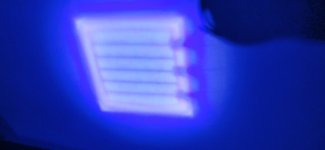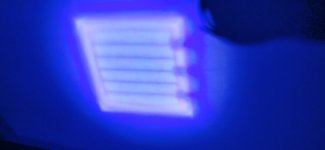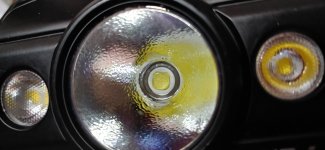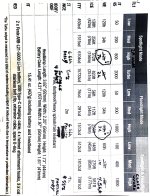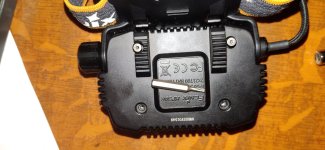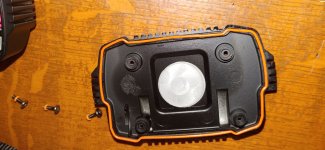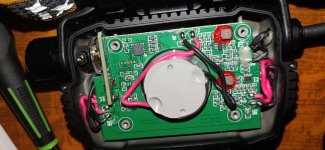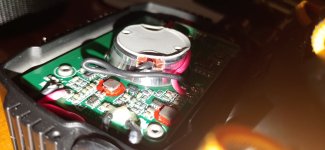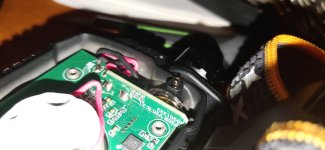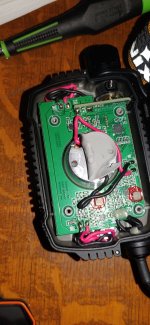degarb
Flashlight Enthusiast
This could become a new standard when advertising a flashlight runtime..
My point of view is from the bosses perspective, as a non smoker who hasn't needed lunch or ever gets hungry during the day, since cutting out my lunch in the 6th grade, because I was about 30 lb overweight. Eating too often bumps up insulin, which is the fat storage hormone, as well as it activates the hypothalamus to stimulate appetite, hunger.
I definitely can see battery swaps being craved by an hourly smoker worker. The more, the merrier! Lol. They don't realize how much these smoke breaks affects their stamina credibility and their value in their boss' eyes.
New test results, fresh off the grill:
Hp30r v2 high flood test: Prediction is same 6h40m as the high spot, based on the Fenix spec table, unless a step down. 200 lumen higher would suggest that these xpgs are more efficient than the xhp50, plus there are two separate pcb separate from each other, which might account for the extra efficiency. The bin is not on the specs.
Started the test at 3 pm. By hour 5, the head isn't too hot and I can put finger over the lens without burning it. I suspect a subtle step down, which is fine since the light is bright. At hour 6, I measured lux, but am having too much wall bounce and I get 1900 lux, rather than the expected 1500 lux. The respectable lux and pure flood is why I like the high flood, which is the first flood that I ever liked and thought useful beyond walking and folding laundry. I then measured relative full diffused lux ratio, which is never accurate testing a spot against a flood. The calculated lumens was just 670, which is probably way off, due to the wildly different beans. I need a trusted flood as the reference flood light. But this is the first flood I ever did not throw away.... At 6h45 min, no distress blinking yet. I really want to go to sleep, but apparently, the light might outlast me. Turned off light 10:30 pm 7.5 hours, due dozing off. Resumed test 5:30 am. At 6 am, 8 hour mark, it was apparent that the high flood had totally cut out, and the light appeared to be on the mid flood. I measured the lux at 1 meter, which came out at 660 lux, which is likely 1.26x high due to flood wall bounce, so real number is likely to be around 500lux, which is 1.66% of the spec sheet mid, albeit 3x lower the the high flood rating. At 8.5 hour mark, it dropped to a pen lit level, fit for walking around, but too low to work by.
Conclusion: the flood got just about 8 hours of useful runtime. However, there was at least one major step down of a 3x magnitude that I did not catch because I was on the verge of falling asleep, which was predicted around the 6h45 minute mark (9:45 pm, when I was on the verge of dozing). Assuming, that 6.75 hours to 8 hours offers 500 to 660 lux, for the last 1.25 hours, this is still brighter than any flood flashlight I have used, and would still be a useful lux for any tasks. I am not not interested in the 8 to 10 or 12 hour pen light, night light mode for serious work, but it is seriously important and needs to be greatly appreciated for safety reasons. All in all, I am greatly impressed with the wise use of the current from 21700s for this mode, despite the fact that my test didn't match the Fenix specifications. But the test does fit the math... Also, while 90 percent of the time we work at least 9.5 hour days, usually 10 hours. 8 hours is a runtime that I can respect, despite leaving us with a functioning head lamp for an hour and a half per day. I can at least see the flashlight designer trying to design a useful light, when I see 8 hours. This good will goes a long way to my confidence in the company who made the light.
[Discussion: 12 hour shifts is a very common practice. However, I do not believe that anything above 10 hours offers enough turn around time for optimal worker output that is sustainable or efficient. On the other hand, a 10 hour workday is sustainable, with 100 percent worker efficiency, even for the guy who needs a greater than average night's sleep, or has other minor health issues that require an extra hour or two to deal with at home... For the 10 hour target, which fits 95 percent of the needs, the per cell draw above .1C per cell is not a good idea for useful work lights. .1 C is a nice round number, and easy to calculate as well. 500 ma per cell. Assuming a 95 percent efficient buck regulator (above 92 percent, is higher than what I am used to) , this is 950 ma to the led, max, which can be squandered by non AR lenses, in efficiency of the led via heat, droop, even reflector inefficiency. The only way to throw up honest higher numbers is initially drive a little heavy and step in an intelligent manner that the user would not notice (keeping the output at least 80 percent for the whole ride-up to 70 percent if enough overhead, meaning candela above 4000, for the purpose of 1000 lux minimum for a person working and bouncing mostly between 1 and 2 meters from their work).
So, I am totally cool with 750 MA coming off each 5000 mah cell, then stepping down to 500 ma per cell, after the first hour. This would give bragging rights to brightness and runtime, by offering a minutes of wow. Before going off to the real work. However, I am not cool with significant step downs being included as part of the runtime on the specs, without breaking it down.
For direct drive and any so called controller that allows linear dimming, a runtime is cut off at 50 percent of initial output, in my book as well many others in this forum who are trying to extract a game plan from the specification numbers. Below this very, very generous 50 percent number, the runtime claims is meaningless. For example, in my naïve early led days, I would buy a light that promised 80 hours, but in reality I could only use the light for an hour before the lux got too low to use for work. Needless to say, the light got immediately returned. This is what I call spec sheet hell!
Fenix put an end to spec sheet hell and saved me lots of wasted time trying other brands of lights, which is why I was so upset by Specification Hell in regards to the hp30r v2 claimed full work day, high modes. I cooled down a little bit when I realized that the low and mid modes specs, mostly fit the math and the mid mostly checked out per test. Getting 8 hours in the high flood, even with a 6.66 ish hour 3x step down, has ameliorated some of my dismay,--since, high flood did offer 8 hours at a useful output. I am not sure how to feel about the high spot being cut down at 6.66 hours, since a drop to 1000 lux or whatever is not very useful for work that requires a Hotspot (such as, bouncing 1 to 2 meters from the work surface, and needing a minimum of 1000 lux to see well).
The short coming of the high spot cost me nearly $70 in addition to the $255 for the hp30r. I got the xstar v8, but I was ticked that I needed to supply my own power supply (Qualcomm 3.0). I am even sure if I chose well on the external charger.... Additionally, battery swapping for the hourly smoker workers, averages about $1500 annually in lost hours, which add up. For myself, I no longer can just grab the light and throw it on the passenger seat when working alone, I must now carry a bookbag and work with the toolbelt added weight and risks of two cells which will need to be swapped around the 6.5 hour mark. I might not even have clean enough hands, so I will be loosing time leaving my work area, scrubbing my hands, then changing cells. If the customer is watching, then my lighting looses credibility, as they will assume that we are constantly swapping cells, and, either dragging out the flat rate job or wasting their money on per hour jobs.]


